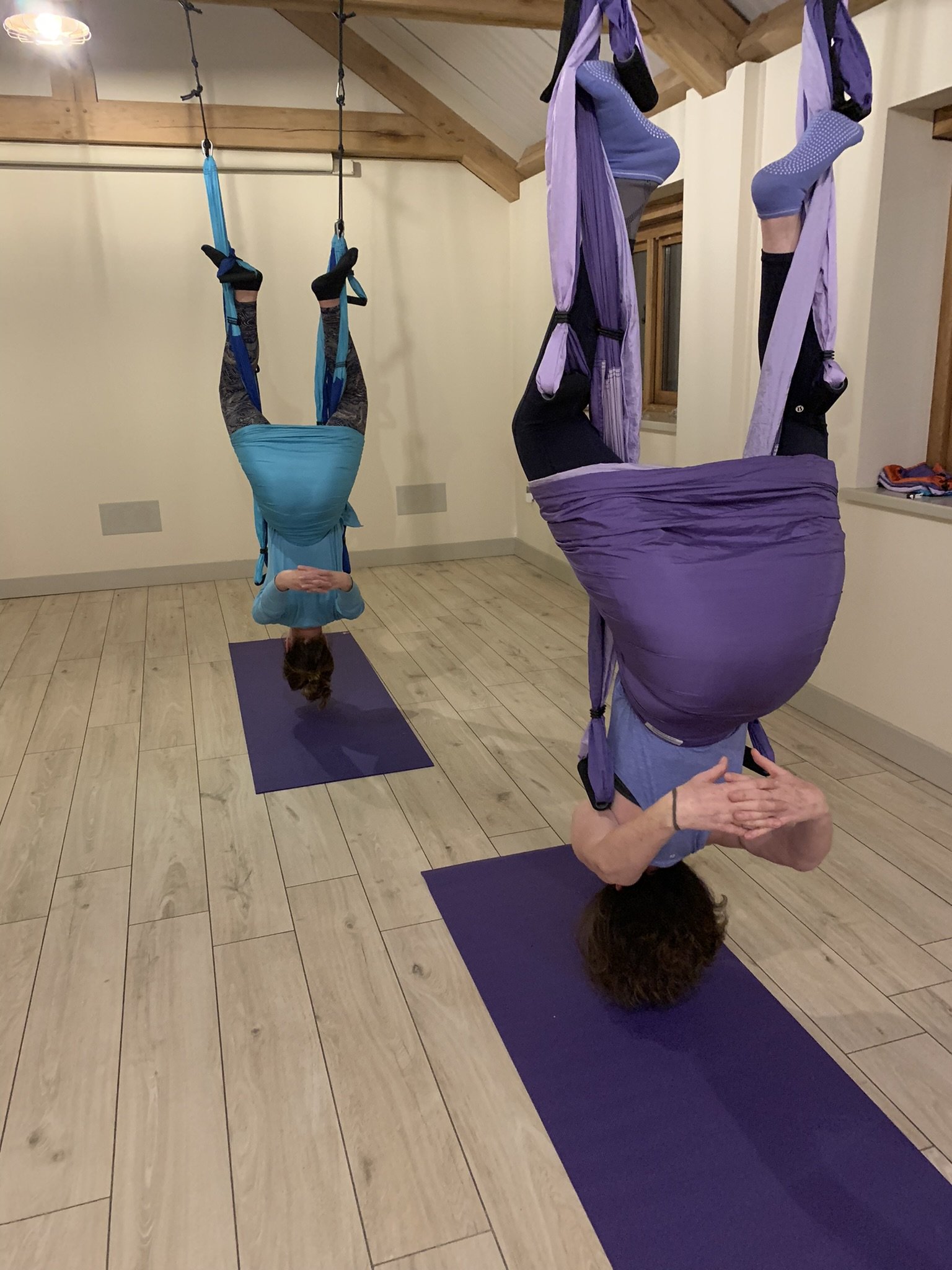When I first decided to try aerial yoga, I envisioned being strung up high from the dome of the Royal Albert Hall by my ponytail, attached to a fuse, which, as it burned, would unleash me spinning Cirque du Soleil-style, landing in the splits an inch from the floor.
I was wrong.
What Happens in my Aerial Yoga Class
Aerial yoga combines traditional yoga postures with the principles of aerial arts*.
At the beginning of the session, you will spend some time suspended in the hammock, allowing the natural swinging movement to lull you into a place of calm. From this starting point, we begin to explore different shapes.
Think of the fabric as your friend, your support system. There are so many poses you can do with the help of the fabric. For instance, consider a splits pose — trying splits on the floor can be intense. But when you try it standing, with one leg supported by the material and you holding onto the fabric for balance, you’ll find you have much more control to explore the pose more deeply.
A portion of the class is dedicated to hanging upside down. Whether you stay there like a bat for minutes or seconds will depend on how you feel and what you fancy doing. Again, think of the material as helping you into a shape — take a handstand as an example. Typically, I fall over after two seconds due to exhaustion or lack of balance. With the material supporting me, I now have time to work out what adjustments I need to make to create the shape-something I might not have enough time to do if I were trying this against the wall.
Finding an aerial yoga class can be challenging, which is one of the reasons why I have chosen a retreat venue that accommodates aerial yoga. Aerial yoga is a fantastic addition to your movement repertoire. It complements traditional yoga practices and encourages you to try shapes that you might not think you can do without substantial support. It also helps decompress the body from more intense activities.
The Origins and History of Aerial Yoga
As with everything yoga related, things aren’t linear and clearly defined. (I’ve had many a debate over a green tea whether a class was ‘Power yoga’ or a ‘Dynamic flow’. If you’re interested, this blog provides an overview: Yoga is Yoga, isn't it? - Exploring different yoga styles. While aerial yoga as we know it today is relatively new, it has its roots in the less modern (but not ancient) practices. Here is my understanding:
Aerial yoga's roots are intertwined with the evolution of modern yoga, particularly the innovations introduced by B.K.S. Iyengar (1918–2014), who emphasized precision and alignment in poses. To help students achieve correct postures and deepen their practice, he introduced various props, including blocks, straps, and rope walls. Notably, Iyengar would suspend students from the ceiling using yoga swings made from ropes, which were padded with mats or blankets.
AntiGravity Yoga
The concept of practicing yoga while suspended in the air began gaining traction in the late 1990s. One of the earliest forms was AntiGravity Yoga, created by Christopher Harrison, a former gymnast and Broadway choreographer. He combined traditional yoga with aerial arts and dance. The first yoga swings emerged in the UK in 2001. These swings featured silk harnesses connected to handles and foot holds, designed to provide support and assist in performing aerial poses. The term "aerial yoga" and the use of the aerial hammock—a single, continuous piece of fabric—started appearing around 2011. The aerial hammock allowed for a wider range of movements and greater versatility in practice.
As with all things yoga it is an ever-evolving practice that is influenced by multiple disciplines. Some styles focus on the acrobatic and performance elements, while others emphasize alignment and deepening traditional yoga postures with the support of the hammock.
Types of Aerial Yoga Equipment
A yoga swing, yoga trapeze, or aerial yoga hammock are all really the same thing: basically suspended pieces of silk-like fabric designed for making some yoga shapes up in the air.
Technically speaking you’ve got:
• Yoga Swing / Trapeze: Typically equipped with handles and designed for dynamic and acrobatic movements. (This is what I use in my classes)
• Yoga Hammock: A continuous loop of fabric that supports static and flowing poses, providing gentle support and deeper stretches.
Handles on swings are often used for added stability and to assist in complex poses, making the practice accessible for those with joint issues, like knee problems.
The Benefits of Aerial Yoga
The use of the hammock allows gentle traction and decompression of the spine, making it accessible for individuals with joint issues or limited mobility. The ability to modify poses and reduce the load on certain body parts, such as wrists and knees.
• Improved Flexibility, Stability, & Balance: A study observed that aerial athletes possess exceptional flexibility, balance, and strength.
• Traction and Joint Decompression: Inversions and hanging postures decompress the joints, countering the effects of gravity and aging.
• Reduced Risk Factors for Heart Disease: A study by the American Council on Exercise found significant reductions in cardiovascular risk factors from aerial yoga .
• Enhanced Mental Health: Aerial arts can improve depression and stress levels, providing a sense of joy and movement.
Who Should Avoid Aerial Yoga
Aerial yoga is not recommended for individuals with certain medical conditions:
• Pregnant women.
• Those with eye conditions such as cataracts or a detached retina.
• Individuals with unregulated blood pressure or cardiovascular issues.
Conclusion
Aerial yoga is a unique practice that is both fun and beneficial, offers numerous physical and mental advantages. It’ll be fun, why not surprise yourself and try?
* Aerial arts include practices such as trapeze, aerial silks, and lyra, involve performing acrobatic movements while suspended in the air – think circus and Cirque du Soleil


